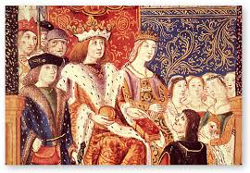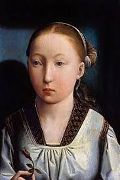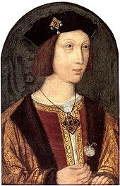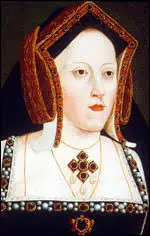Catherine of Aragon
The first and perhaps most famous wife of England's King Henry VIII was royalty herself, the daughter of Spain's ruling family. She was Catherine of Aragon. 
Her parents were the famous King Ferdinand II of Aragon and Isabella I of Castille, whose marriage unified two of Spain's largest territories (and, eventually, Spain itself) and created a unified empire that, among other things, sponsored Christopher Columbus's voyages to the New World. The youngest of five children, Catherine was born Dec. 16, 1485, in Madrid. All of her siblings eventually married into European royalty, including her sister Joanna of Castile, who married Philip, Duke of Burgundy and gave birth to two Holy Roman Emperors, Charles V and Ferdinand I. 
As the daughter of top royalty, Catherine received a top-notch education, from the famed instructor Alessandro Gerladini. A bright child, she studied arithmetic, law, history, classical literature, philosophy, French, Greek, and Latin. In addition, she learned crafts traditionally assigned to women at this time, such as cooking, embroidery, lace-making, sewing, spinning, and weaving. Like her mother, she was very religious and studied the tenets of the Catholic faith as well. 
When Catherine was 15, she married Prince Arthur of England (left), the oldest son of King Henry VII and Elizabeth of York. This was an attempt to provide a more solid alliance between England and Spain. In fact, the two were betrothed 12 years earlier. Arthur and Catherine were married in 1501, when they were both 15. Arthur died a few months later, and Catherine for a time served as Spain's Ambassador to England; in this, she was the first woman to serve as an European ambassador. The English king and queen's second son was also named Henry. Henry wanted the same alliance with Spain that his father did (not to mention to keep the rather large dowry that Catherine's parents had paid in Like most monarchs, Henry wanted a son to succeed him on the throne. Catherine gave birth to four children who died either immediately or within a few weeks. Finally, in February 1516, the couple had a healthy baby–a girl, whom they named Mary. That was the only healthy child that Catherine ever had. Most historical reports say that Henry and Catherine were happy in their initial years as king and queen. Henry was often away on campaign, fighting at various times against France and Spain. Henry meddled in a European Continental alliance for a time and then invaded France, in June 1513. The English army, with Henry at its head, enjoyed success at the Battle of the Spurs. While king and army were in France, however, In 1525, Henry, then 34, became convinced that he and Catherine, who was now 40, would be unable to produce a healthy son, so he sought to divorce her and marry someone else. He appealed to Pope Clement VII for an annulment of the marriage to Catherine. The pope refused, in part for political reasons (not the least of which was that Catherine's nephew was Charles V, the Holy Roman Emperor) and in part because he did not want to contradict the ruling of one of his predecessors. 
Pope Clement VII took his time in announcing his decision. Refusing to wait, Henry ordered Catherine banished from court and sent away to live somewhere else. King and queen had separate rooms in the royal residence, and one of Catherine's ladies-in-waiting, Anne Boleyn, moved into Catherine's rooms. Henry had decided that he wanted Anne, not Catherine, by his side. Henry suggested pointedly that Catherine retire to a convent. Her pointed reply: “God never called me to a nunnery. I am the King’s true and legitimate wife.” In 1533, when his desire for a healthy son overwhelmed his need to keep the peace with the Pope, Henry convinced his top religious official, Archbishop of Canterbury Thomas Cranmer, to declare his marriage to Catherine null and void. Catherine was sent away from court entirely, and her daughter, Mary, was removed as a possible heir to the throne. Henry declared Catherine to be the Princess Dowager of Wales, a title that Catherine refused. She also did not recognize him as head of the Church in England and did not grant Henry's request to send her crown jewels to her replacement. 
Catherine was sent to a series of other damp and unpleasant residences, with few staff to look after her. Often ill and with few friends left, she spent much of her time in prayer. She died on Jan. 7, 1536, at Kimbolton Castle. She was 50. Her last letter to King Henry VIII was a love letter, which she signed "Catherine the Queen." She was still popular with many people, and the period of mourning for her was brief but intense around the country. Her daughter went on to become Queen of England in her own right. |
|
Social Studies for Kids
copyright 2002–2025
David White



 England), and he wanted to cement this alliance in the same way that his father had, by marriage. Henry wanted to marry his brother's widow, Catherine of Aragon. Henry needed permission from Pope Julius II to do this, and he had to apply for a dispensation, which was, in effect, a ruling by the Pope that Catherine's original marriage, to Arthur, was invalid. The Pope granted the dispensation; the young people were officially betrothed in 1503 but were not married until they had to be, when the king had died. Henry and Catherine were married on June 11, 1509; thus, 13 days later, when
England), and he wanted to cement this alliance in the same way that his father had, by marriage. Henry wanted to marry his brother's widow, Catherine of Aragon. Henry needed permission from Pope Julius II to do this, and he had to apply for a dispensation, which was, in effect, a ruling by the Pope that Catherine's original marriage, to Arthur, was invalid. The Pope granted the dispensation; the young people were officially betrothed in 1503 but were not married until they had to be, when the king had died. Henry and Catherine were married on June 11, 1509; thus, 13 days later, when  the Scottish king,
the Scottish king, 
